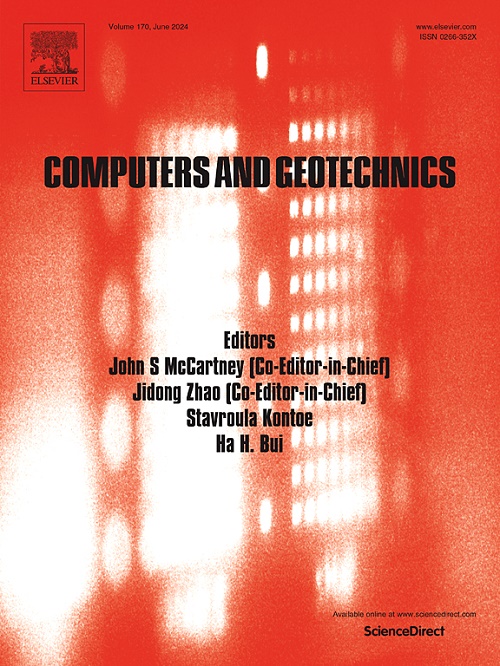Distinct element modelling of stress wave propagation in rock masses considering asymmetrical loading/unloading behavior of filled fracture: Unique compression-hardening and memory effect
IF 6.2
1区 工程技术
Q1 COMPUTER SCIENCE, INTERDISCIPLINARY APPLICATIONS
引用次数: 0
Abstract
Dynamic loads like seismic and blasting waves, exhibit characteristics such as variable frequency, amplitude, and multiple cycles. These loads can induce cyclic loading and unloading of fractures in rock masses, progressively altering the mechanical properties of the fractures and affecting the propagation of stress waves. However, existing models are unable to capture the above process. Experimental investigations reveal filled fractures’ unique compression-hardening and memory effects under cyclic loading/unloading, characterized by asymmetric loading/unloading behaviors. To capture this characteristic, we developed a modified Barton-Bandis model in UDEC 7.0 that incorporates asymmetric loading/unloading (BBLU), successfully replicating the cyclic loading and unloading behavior of filled fractures. The simulation results of stress wave propagation in fractured rock masses with asymmetric loading/unloading behavior show that compressive stress waves lead to stiffness hardening of the fractures and suppress the attenuation of stress wave frequency. Notably, compression hardening and memory effects retain the stiffness hardening from previous loading/unloading cycles. Under the influence of multi-cycle waves, this results in cumulative deformation, enhancing the transmission capacity of stress waves. In multi-fractured rock masses, stress waves experience multiple reflections at the fractures, where the memory effect reduces the ability of the fractures to reflect stress waves and compresses the wavelength. This dual mechanism weakens the superposition of multiple reflected waves. These findings bridge theoretical models with real-world fracture mechanics, enhancing prediction of wave-driven damage progression and hazard mitigation in underground engineering-particularly under cyclic disturbances and complex fracture networks. This research redefines structural control evaluations for rock mass dynamics under multiparameter interactions, offering transformative insights for engineering safety optimization.
考虑充填裂隙非对称加载/卸载行为的岩体应力波传播的独特单元模型:独特的压缩硬化和记忆效应
像地震波和爆破波这样的动载荷,表现出频率、振幅和多周期变化等特点。这些荷载会诱发岩体裂隙的循环加卸载,逐渐改变裂隙的力学特性,影响应力波的传播。然而,现有的模型无法捕获上述过程。实验研究表明,充填裂缝在循环加卸载作用下具有独特的压缩硬化和记忆效应,表现为非对称加卸载行为。为了捕捉这一特征,我们在UDEC 7.0中开发了一个改进的Barton-Bandis模型,该模型包含了不对称加载/卸载(BBLU),成功地复制了充填裂缝的循环加载和卸载行为。应力波在非对称加载/卸载裂隙岩体中的传播模拟结果表明,压应力波导致裂隙刚度硬化,抑制应力波频率的衰减。值得注意的是,压缩硬化和记忆效应保留了先前加载/卸载循环的刚度硬化。在多周波的作用下,产生累积变形,增强了应力波的传播能力。在多裂缝岩体中,应力波在裂缝处经历多次反射,记忆效应降低了裂缝反射应力波的能力,压缩了波长。这种双重机制削弱了多个反射波的叠加。这些发现将理论模型与实际裂缝力学联系起来,增强了地下工程中波浪驱动损伤进展的预测和危害缓解,特别是在循环扰动和复杂裂缝网络下。该研究重新定义了多参数相互作用下岩体动力学的结构控制评价,为工程安全优化提供了革命性的见解。
本文章由计算机程序翻译,如有差异,请以英文原文为准。
求助全文
约1分钟内获得全文
求助全文
来源期刊

Computers and Geotechnics
地学-地球科学综合
CiteScore
9.10
自引率
15.10%
发文量
438
审稿时长
45 days
期刊介绍:
The use of computers is firmly established in geotechnical engineering and continues to grow rapidly in both engineering practice and academe. The development of advanced numerical techniques and constitutive modeling, in conjunction with rapid developments in computer hardware, enables problems to be tackled that were unthinkable even a few years ago. Computers and Geotechnics provides an up-to-date reference for engineers and researchers engaged in computer aided analysis and research in geotechnical engineering. The journal is intended for an expeditious dissemination of advanced computer applications across a broad range of geotechnical topics. Contributions on advances in numerical algorithms, computer implementation of new constitutive models and probabilistic methods are especially encouraged.
 求助内容:
求助内容: 应助结果提醒方式:
应助结果提醒方式:


